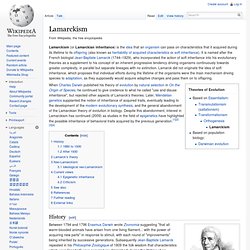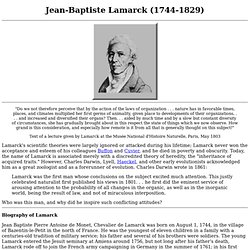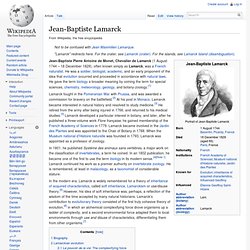

Evolution and Lamarck: Lamarck: The theory of transformation. Though he was building on the work of his mentor, Count George-Louis Leclerc de Buffon, Jean-Baptiste Lamarck (1744-1829) is often credited with making the first large advance toward modern evolutionary theory because he was the first to propose a mechanism by which the gradual change of species might take place.

Also, he extended the definition of the change over time, saying that life started out simple and became more complex. In 1809 he published Philosophie Zoologique, in which he described a two part mechanism by which change was gradually introduced into the species and passed down through generations. His theory is alternatively referred to as the theory of transformation or simply Lamarckism. Though today Lamarck's work is considered a major step forward, in his lifetime he did not receive much recognition. Use and Disuse Figure%: Use and disuse in the evolution of the neck of the giraffe These two examples demonstrate how use could change a trait. Lamarckian Inheritance. Lamarckism. Lamarckism (or Lamarckian inheritance) is the idea that an organism can pass on characteristics that it acquired during its lifetime to its offspring (also known as heritability of acquired characteristics or soft inheritance).

It is named after the French biologist Jean-Baptiste Lamarck (1744–1829), who incorporated the action of soft inheritance into his evolutionary theories as a supplement to his concept of an inherent progressive tendency driving organisms continuously towards greater complexity, in parallel but separate lineages with no extinction. Lamarck did not originate the idea of soft inheritance, which proposes that individual efforts during the lifetime of the organisms were the main mechanism driving species to adaptation, as they supposedly would acquire adaptive changes and pass them on to offspring.
History[edit] 1880 to 1930[edit] After 1930[edit] Since 1988 certain scientists have produced work proposing that Lamarckism could apply to single celled organisms. Jean-Baptiste Lamarck (1744-1829) : works and heritage. Early Concepts of Evolution: Jean Baptiste Lamarck. Early Concepts of Evolution: Jean Baptiste Lamarck Darwin was not the first naturalist to propose that species changed over time into new species—that life, as we would say now, evolves.

In the eighteenth century, Buffon and other naturalists began to introduce the idea that life might not have been fixed since creation. By the end of the 1700s, paleontologists had swelled the fossil collections of Europe, offering a picture of the past at odds with an unchanging natural world. And in 1801, a French naturalist named Jean Baptiste Pierre Antoine de Monet, Chevalier de Lamarck took a great conceptual step and proposed a full-blown theory of evolution. Lamarck started his scientific career as a botanist, but in 1793 he became one of the founding professors of the Musee National d'Histoire Naturelle as an expert on invertebrates.
Organisms driven to greater complexity This sort of evolution, for which Lamarck is most famous today, was only one of two mechanisms he proposed. Jean-Baptiste Lamarck (1744-1829) Lamarck's scientific theories were largely ignored or attacked during his lifetime; Lamarck never won the acceptance and esteem of his colleagues Buffon and Cuvier, and he died in poverty and obscurity.

Today, the name of Lamarck is associated merely with a discredited theory of heredity, the "inheritance of acquired traits. " However, Charles Darwin, Lyell, Haeckel, and other early evolutionists acknowledged him as a great zoologist and as a forerunner of evolution. Charles Darwin wrote in 1861: Who was this man, and why did he inspire such conflicting attitudes?
Jean-Baptiste Lamarck. Lamarck fought in the Pomeranian War with Prussia, and was awarded a commission for bravery on the battlefield.[2] At his post in Monaco, Lamarck became interested in natural history and resolved to study medicine.[3] He retired from the army after being injured in 1766, and returned to his medical studies.[3] Lamarck developed a particular interest in botany, and later, after he published a three-volume work Flore française, he gained membership of the French Academy of Sciences in 1779.

Lamarck became involved in the Jardin des Plantes and was appointed to the Chair of Botany in 1788. When the Muséum national d'Histoire naturelle was founded in 1793, Lamarck was appointed as a professor of zoology. In 1801, he published Système des animaux sans vertèbres, a major work on the classification of invertebrates, a term he coined. Biography[edit] With a reduced pension of only 400 francs a year, Lamarck resolved to pursue a profession.